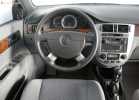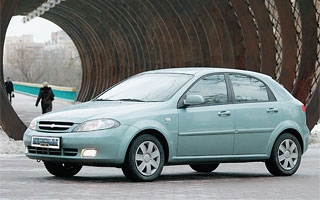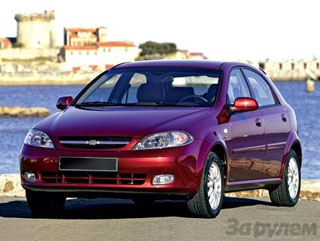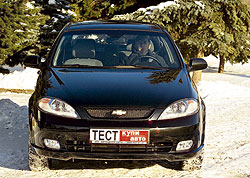Test Drive Chevrolet Lacetti Sedan since 2004 Sedan
Honestly! Chevrolet Lacetti.
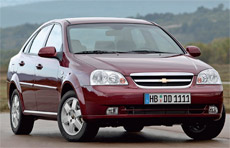 Daewoo? Who said my name is Daewoo? I Chevrolet! Say what you want, but we will not be cheating. We know the car that is trying to give for Chevrolet, in fact Daewoo Nubira / Lacetti. But on the radiator grill, the cross Chevrolet is real, the Americans have attached their symbolism to the Korean car quite consciously
Daewoo? Who said my name is Daewoo? I Chevrolet! Say what you want, but we will not be cheating. We know the car that is trying to give for Chevrolet, in fact Daewoo Nubira / Lacetti. But on the radiator grill, the cross Chevrolet is real, the Americans have attached their symbolism to the Korean car quite consciously Why did they allow the corporate emblem to wear some Korean car, really not enough products? It turns out, little: the purebred models of this brand (if we are not talking about Corvette or SUVs) by no means a car skyscland, and in Europe they do, in general, nothing. Then the Korean company, which is from a certain time under the wing of American auto giant, and helped out: as it turned out, she produces far from the worst cars! Moreover, those that are in sustainable demand in the old world. There are Americans in the end and sent them a novelty, but under your own name (noteworthy fact: in America Lacetti and Evanda were sold under the brand of the Japanese company Suzuki). It is impossible to say that success was stunning, but still had a place, especially in our country, where Lacetti has been implemented for five years. A considerable term for the car, and even in difficult Russian conditions of operation! All this allows you to make quite concrete and reliable conclusions about the reliability of the model.
Chevrolet Lacetti.
Specifications
Body type
sedan Universal Hatchback
Number of doors 4 5 5
Number of places 5
Length, mm 4515 4580 4295
Width, mm 1725
Height, mm 1445 1460 1445
Wheel base, mm 2600 2660 2600
Road clearance, mm 160
Front suspension
Rear independent suspension, with MacPherson racks
Independent, with MacPherson racks
Drive type front
Brakes front
Brake rear disc ventilated
Disk
Gas tank volume, l 60
Acceleration up to 100 km / h, s * 11.5
Max. Speed, km / h * 170
Fuel consumption (city / route), L * 11.2 / 6.2
* Data for a car with a motor of 1.6 liters and automatic transmission.
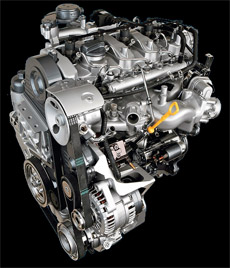 Not so long ago, it was not difficult to build a wide range of bodyworks, because many outdoor parts in cars with different types of hulls were identical (at least the entire front part). Now it has become fashionable to offer several different cars under the same name (for example, modern Honda Civic). We dare to assume that Lacetti at one time became one of the first cars (current waves, in any case), who passed on this path. So, the sedan and the wagon are similar, but with the hatchback they have nothing in common: the hatchback is rounded and mild, while the wagon with the four-door is noticeably more stringent, faceted. As for the durability of the body, it, alas, not at the height: the chip-paints appeared on the paint and varnish coating soon turn into rusty stains. In addition, it is not a nonsense of the electrician: the owners often complain about non-working lowlights of headlights, malfunctions in the windshield washer, as well as unstable (and noisy) work climate installation.
Not so long ago, it was not difficult to build a wide range of bodyworks, because many outdoor parts in cars with different types of hulls were identical (at least the entire front part). Now it has become fashionable to offer several different cars under the same name (for example, modern Honda Civic). We dare to assume that Lacetti at one time became one of the first cars (current waves, in any case), who passed on this path. So, the sedan and the wagon are similar, but with the hatchback they have nothing in common: the hatchback is rounded and mild, while the wagon with the four-door is noticeably more stringent, faceted. As for the durability of the body, it, alas, not at the height: the chip-paints appeared on the paint and varnish coating soon turn into rusty stains. In addition, it is not a nonsense of the electrician: the owners often complain about non-working lowlights of headlights, malfunctions in the windshield washer, as well as unstable (and noisy) work climate installation. Inside Lacetti seems to be a budget car, but the cabin clearly makes it clear that Korea has moved away from the part of the skill to design cars: it looks all modest, but it's pretty, there is enough space in the cabin, and it is convenient to use the equipment. Plastic is applied albeit not the highest grade, but in principle not the very bad quality (although in European cars it is much more pleasant). You can sing on mediocre noise insulation that is treated, truth is not completely, the installation of the shoes. It also grieves the rather small luggage compartment of the hatchback. Its volume is less than 300 liters.
Nobody is waiting for a brilliant behavior on the road: they are buying those who need good-quality wheels. Moreover, nothing terrible in the behavior of Lacetti is still not: it is managed by Chevrolet quite worn, it slows down well, and it accelerates enough vigorous (all motors, except the volume of 1.4 liters, are very responsive and elastic, and an automatic box at the level). Alas, the smoothness of the stroke is mediocre: on our far from smooth roads a harsh suspension causes Lacetti to ride.
The engines are not much in the line, but not enough. The weakest has a working volume of 1.4 liters and develops the power of 97 hp The next unit is 1.6-liter 109-strong (it is considered the most optimal). The difference in the return between the 1.8-liter motor and four of 1.6 liters is approximately the same as between the last and basic source of movement (in this way, the most powerful engine produces 122 forces). Like most modern cars, Lacetti should be driven into service every 15 thousand km (it is with such an interval.
 change the oil in the engine, as well as the cabin filter). After 30 thousand. It is desirable to change the candles (it would not hurt to upgrade both the brake fluid), and after 45 thousand km fuel and air filters, as well as the cooling fluid in the motor. And at every fourth, it is necessary to replace the timing belt. Everything? No, not all: more serious problems are possible. In particular, in machines released until mid-2007, due to resinous sediments (which occurred, by the way, due to our rubbish gasoline, the quality of which Lacetti is rather demanding) hung, and sometimes valves were rooted. Later they made changes to the design of the engine (ailment concerned versions equipped with 1.4 and 1.6 L motor motors). Of course, the control electronics fails: Check Engine light lights up on the instrument panel, signaling about the malfunction in the exhaust gas recycling system.
change the oil in the engine, as well as the cabin filter). After 30 thousand. It is desirable to change the candles (it would not hurt to upgrade both the brake fluid), and after 45 thousand km fuel and air filters, as well as the cooling fluid in the motor. And at every fourth, it is necessary to replace the timing belt. Everything? No, not all: more serious problems are possible. In particular, in machines released until mid-2007, due to resinous sediments (which occurred, by the way, due to our rubbish gasoline, the quality of which Lacetti is rather demanding) hung, and sometimes valves were rooted. Later they made changes to the design of the engine (ailment concerned versions equipped with 1.4 and 1.6 L motor motors). Of course, the control electronics fails: Check Engine light lights up on the instrument panel, signaling about the malfunction in the exhaust gas recycling system. But the gearbox has proven themselves as very reliable: none of the owners of these cars do not even remember that something terrible (affects, apparently, the comparative weakness of power units, even the most voluminous one). No one, however, has not canceled the replacement of the clutch: it is good, which is less than 100 thousand km, it usually does not serve.
The chassis also feels not bad, and our roads are not able to harm her. In any case, all breakdowns, the screens and knock are unsystematic character, there are no chronically weaknesses (after the suspension is bulkhead with the replacement of shock absorbers, ball supports and
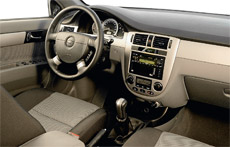 another small details can be thousands of 70, or even more ride and nothing to worry about). In addition to one: in cars released until 2007, a steering rail began to knock pretty quickly. In addition, steering malfunctions are happening: each second lacetti is clearly audible, as the power steering sweat whistles.
another small details can be thousands of 70, or even more ride and nothing to worry about). In addition to one: in cars released until 2007, a steering rail began to knock pretty quickly. In addition, steering malfunctions are happening: each second lacetti is clearly audible, as the power steering sweat whistles. In general, the Chevrolet cross is attached to this car without in vain: Lacetti is quite a good vehicle, albeit is not super-expen, but also not delivering special troubles during operation. Just do not forget that even before the relationship with the Americans, Koreans mastered the release of quite normal cars, long ago, by a long time, he had the stage that today is trying to pass, for example, Chinese and Russian manufacturers. So if someone saves whom is, then the Koreans of Americans, and not vice versa. And Lacetti is quite worthy to be called a world-class product. With the only reservation that this is, although the good, but still the budgetary car.
Advantages and disadvantages of the model
Advantages
Acceptable handling, spacious salon, pretty exterior
disadvantages
Tiny trunk at hatchback, mediocre smoothness, average quality of finishing materials
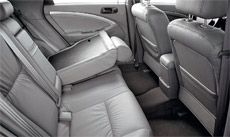
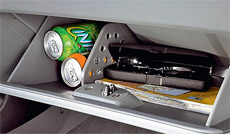
A source: Magazine cars and prices April 13, 2009.
Video Test Drives Chevrolet Lacetti Sedan since 2004
Test Drives Chevrolet Lacetti Sedan since 2004
CHEVROLET LACETTI Sedan faults since 2004
Chevrolet Laceti malfunctions: details| Lacetti Sedan since 2004 | |
|---|---|
| Engine |  |
| Transmission |  |
| Management and suspension system |  |
| Brake system |  |
| Heated air and air conditioning |  |
| Start and Charging System |  |
| Electrical components and other |  |
| Body stability to corrosion |  |

